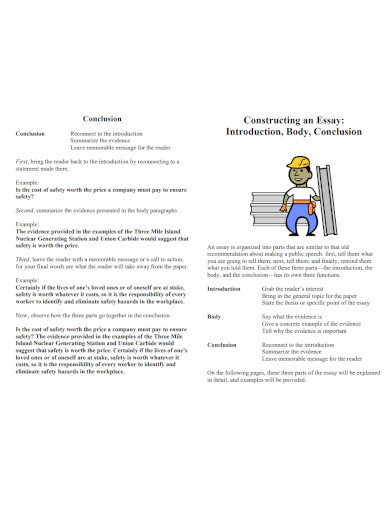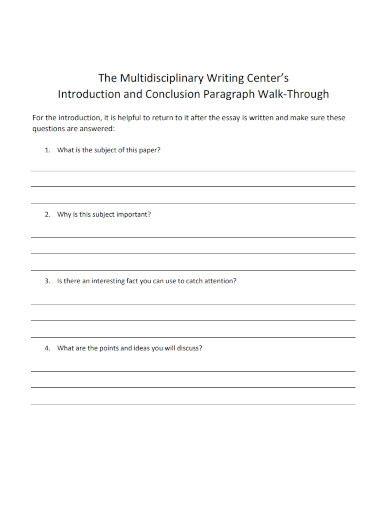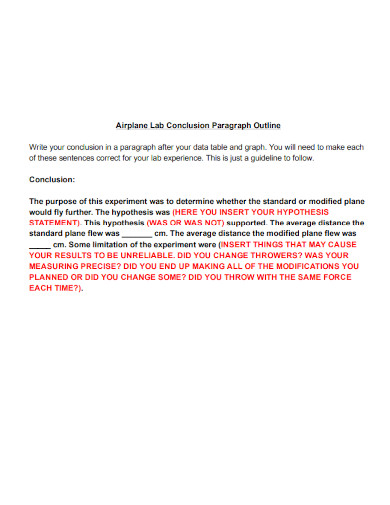16+ Conclusion Paragraph Examples to Download
A lot of readers place a large emphasis on the ending of the text they are reading. This ending can lead to the enjoyment or disappointment of the reader. A good article or research paper has a masterfully written conclusion paragraph that will impress and impact the reader.
What is Conclusion Paragraph?
A conclusion paragraph is the final section of a piece of writing, intended to summarize the main points, reflect on the implications, or restate the thesis in light of the evidence presented. It serves as the closure for the argument or narrative, providing a sense of completeness and tying together the key elements discussed throughout the text. The conclusion paragraph aims to leave the reader with a clear understanding of the main message, any conclusions drawn, and, in some cases, a call to action or a thought to ponder.
Strategies for writing an effective conclusion
- Restate the Thesis: Paraphrase your main argument to remind readers of your essay’s core message.
- Summarize Key Points: Concisely recap the main points of your essay, linking them back to the thesis.
- Reflect on the Implications: Discuss the broader significance or implications of your findings.
- Include a Call to Action: Urge readers to take specific actions or reconsider their views based on your argument.
- End with a Quotation or Anecdote: Use a poignant quote or anecdote to leave a lasting impression.
- Connect to a Larger Context: Link your argument to broader themes or discussions to show its relevance.
- Pose a Rhetorical Question: Engage readers by leaving them with a thought-provoking question.
- Echo the Introduction: Refer back to your introduction’s hook or a key idea to bring your essay full circle.
- Highlight the Significance: Emphasize the importance of your findings or argument and why it matters.
- Offer a Final Thought: Leave readers with a compelling final insight or reflection on your topic.
Strategies to avoid
- Overuse of Jargon or Complex Language: Avoid using unnecessarily complex words or industry-specific jargon that may not be familiar to your audience.
- Repetition of Ideas: Steer clear of repeating the same ideas or phrases, which can make your writing seem redundant or uninspired.
- Introducing New Information in the Conclusion: The conclusion should synthesize your work, not introduce new arguments or evidence.
- Overgeneralization: Avoid making broad generalizations that cannot be supported by your evidence or analysis.
- Using Passive Voice Excessively: While sometimes necessary, overusing passive voice can make your writing seem weak or unclear. Use active voice when possible.
- Ignoring the Audience: Don’t forget to consider your audience’s knowledge level, interests, and needs, which can lead to disengagement.
- Failure to Proofread: Skipping the proofreading step can result in errors that distract from your message and diminish your credibility.
- Relying Heavily on Quotes: While supporting evidence is crucial, relying too heavily on quotes can stifle your voice and originality.
- Inappropriate Tone: An overly casual or conversational tone may not be appropriate for formal writing, just as overly formal language can alienate in more casual contexts.
- Being Too Vague or Abstract: Provide concrete examples and clear explanations rather than relying on vague assertions or overly abstract concepts.
Types of conclusion
1. Summary Conclusion
- Description: Recaps the main points of the text, reinforcing the thesis without introducing new information.
- Use: Effective for complex arguments or long texts to remind readers of key points.
2. Reflective Conclusion
- Description: Offers reflections or insights gained from the argument or narrative.
- Use: Suitable for personal essays or papers that explore processes or changes over time.
3. Call to Action Conclusion
- Description: Urges the reader to take specific actions based on the argument presented.
- Use: Ideal for persuasive essays or speeches where the goal is to motivate change.
4. Quotation Conclusion
- Description: Ends with a relevant quote that highlights the main theme or message.
- Use: Adds depth or a broader context to the discussion, useful in analytical or reflective writing.
5. Solution Proposal Conclusion
- Description: Proposes a solution to a problem discussed in the text.
- Use: Effective in problem-solution essays or policy papers.
6. Question Conclusion
- Description: Ends with a rhetorical question that leaves the reader thinking about the topic.
- Use: Engages readers by encouraging them to ponder the implications or broader significance of the topic.
7. Prediction Conclusion
- Description: Offers a prediction about the future of the topic discussed.
- Use: Suitable for topics related to trends, policies, or ongoing issues, adding a forward-looking perspective.
8. Universal Statement Conclusion
- Description: Concludes with a broad, universal statement or truth that resonates beyond the specific topic.
- Use: Effective for tying individual experiences or topics to broader human conditions or truths.
9. Echo Conclusion
- Description: Echoes a theme, phrase, or concept introduced at the beginning, bringing the argument full circle.
- Use: Creates a cohesive and satisfying structure, especially in narrative or thematic writing.
10. Consequential Conclusion
- Description: Highlights the consequences or outcomes that may arise from the discussion.
- Use: Useful in argumentative essays to underscore the importance of the topic or the need for action.
When to use a conclusion
- End of an Essay or Report: To summarize main points, restate the thesis in light of the evidence presented, and provide closure.
- After Presenting an Argument: To reiterate the significance of your argument and its implications, encouraging the reader to consider your perspective.
- Completion of a Research Paper: To highlight key findings, discuss their implications, and suggest areas for future research.
- At the End of a Presentation: To summarize key takeaways, reemphasize the central message, and possibly propose a call to action.
- Closing a Narrative or Story: To reflect on the events or themes presented and offer a sense of resolution or continuation.
- In Persuasive Writing: To reinforce your position one last time, summarize supporting arguments, and motivate the audience towards a specific action or belief.
- Following a Discussion or Analysis: To encapsulate the main insights gained, the significance of the discussion, and its broader impact or importance.
- Concluding a Proposal: To reassert the benefits and feasibility of your proposal, and prompt the recipient to take the desired action.
- Ending an Article or Blog Post: To tie together key points, restate the main idea, and leave the reader with a thought-provoking conclusion or call to engagement.
- In Academic Examinations: To succinctly summarize your responses and demonstrate a comprehensive understanding of the topic.
18+ Conclusion Paragraph Examples
1. Conclusion Paragraph Template
2. Example Conclusion Paragraph
3. Conclusion Paragraph Format
4. Conclusion Paragraph Constructing an Essay
5. Introduction and Conclusion Paragraph Walk
6. Pearl Conclusion Paragraph
7. Structuring Conclusions Paragraph
8. Conclusion Sentences for Paragraphs
9. Basic Conclusion Essay Format
10. Airplane Lab Conclusion Paragraph Outline
11. Creating an Essay Conclusion Plan
12. Research Paper Conclusion Paragraph
13. Complaint Formal Letter Conclusion
14. Good Concluding Paragraph
15. Conclusion Argumentative Essay
16. Body Conclusion Paragraph Example
17. Outline for Conclusion Five-Paragraph Essay
Importance of conclusion
- Provides Closure: The conclusion offers a sense of completion and closure to the readers, wrapping up the discussion or narrative in a coherent and satisfying way.
- Summarizes Key Points: It succinctly summarizes the main arguments or points discussed, reinforcing them in the reader’s mind and ensuring a clear understanding of the material.
- Emphasizes the Thesis: A conclusion reiterates the thesis statement, reminding readers of the central argument or purpose of the piece and emphasizing its significance.
- Leaves a Lasting Impression: The final words of a conclusion have the power to leave a lasting impression on the reader, influencing how they remember and think about the topic.
- Encourages Action or Reflection: Conclusions often include a call to action or a thought-provoking statement, encouraging readers to act upon the information provided or reflect further on the topic.
- Shows the Research’s Significance: In academic writing, the conclusion highlights the importance of the research or argument, suggesting potential applications or implications for further study.
- Enhances Flow and Cohesion: A well-crafted conclusion enhances the overall flow and cohesion of the writing, ensuring that it transitions smoothly from the body to the end.
- Addresses the ‘So What?’ Question: It answers the critical “So what?” question, explaining why the discussion or argument matters and its relevance to the reader or the broader field.
FAQs
What are the 3 Parts of a Conclusion Paragraph?
The three main parts of a conclusion paragraph are: 1) restatement of the thesis to remind the reader of the main argument, 2) a summary of the key points discussed in the essay, and 3) a final statement that may include implications, future research directions, or a call to action.
What is a Good Conclusion Paragraph Sentence?
A good conclusion paragraph sentence effectively encapsulates the essence of the argument or discussion, leaves the reader with a lasting impression, and provides closure, such as “This journey underscores the power of resilience in the face of adversity.”
How Can I Start My Conclusion?
You can start your conclusion with phrases that signal closure and reflection, such as “In conclusion,” “To sum up,” “Ultimately,” or “Having considered all aspects,” followed by a brief restatement of the thesis or main points.
What is a Good Way to End a Conclusion?
A good way to end a conclusion is with a powerful final sentence that leaves a lasting impact, such as a thought-provoking question, a call to action, a quotation that encapsulates your argument, or a forward-looking statement.
Can a Conclusion be 5 Sentences?
Yes, a conclusion can be 5 sentences. This length allows for a concise restatement of the thesis, a summary of key points, and a final statement, providing a thorough yet succinct closure to the essay.
How Do You Write a High School Conclusion Paragraph?
To write a high school conclusion paragraph, start by restating your thesis in a new way, summarize the main points you made in your essay, and conclude with a statement that reflects on the significance of your argument or provides insight into the implications of your findings
Why is it important to conclude an article?
A conclusion paragraph is the final part of an article or a quantitative or qualitative research report that closes the overall article and summarizes the content. This part of the text is very important as it will contain recommendations or a call to action that will prompt the audience on how to use that researcher’s obtained information. Not only that, but a conclusion will also ensure that the reader will reach or understand the overall point and purpose of the whole text while referencing the introduction and the main topic of the text.
What makes a strong conclusion?
A strong conclusion will restate the introduction and the main idea of the text or writing. Not only does the conclusion connect the reader back to the beginning of the text, but the conclusion will also connect the ideas brought about by the introduction to the points raised in the body of the text. A strong conclusion will also end with a small call to action or a recommendation of how to use the points in future research and actions.
What is the importance of a good conclusion?
A good conclusion will heavily impact the reader’s stance, ideas, and impression of the whole topic of the article or the research paper. Not only will a good conclusion affect the various contextual understanding of the reader, but it will also affect the chance of the reader will reread and reference the article or research paper. All of these factors illustrate why a good conclusion is very important.
A conclusion paragraph is the final part of one’s article or paper that will summarize all the points raised in the body of the text. A well-written conclusion paragraph will is the product of good planning, writing, and logic. Good conclusion paragraphs can improve the audience or the reader’s understanding, and impression, while improving the likelihood of the article being reread and referenced in the future.


















